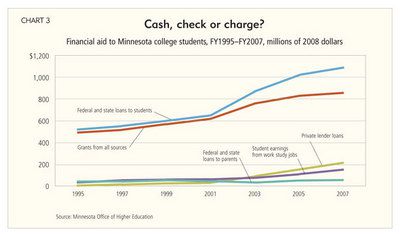At the beginning of a Capitol rally in St. Paul today, Gov. Mark Dayton apologized to protesting higher education students for what his generation “did to financial aid.”
Presumably my colleague, Alex Friedrich, is going to jump into this on his excellent On Campus blog, but what exactly did Dayton’s generation do to financial aid?
Ronald Wirtz, the editor of Fedgazette from the Federal Reserve Bank of Minneapolis, answered that question in a 2009 study. The short answer: A lot. But, like so many statistical arguments, it all depends on how you look at the numbers.
Take grant aid, for example:
Most of these spigots have been pouring out much more–not less–money over time. From 1997 to 2007, inflation-adjusted grant aid to Minnesota students grew by 74 percent. Institutional grants and tuition discounts accounted for almost half of all grant aid in 2007, at about $417 million, with the other half made up of federal, state and private grant aid.
Institutional aid is doled out in many forms and programs. For example, at the University of Minnesota, the Founders Free Program promises grant and gift assistance equal to tuition and required fees for any state resident who has been admitted as a first-time, full-time student, completes the Federal Application for Financial Student Aid and is eligible for a Pell grant (which indicates financial need, though a student does not necessarily have to be low-income). Started in 2005 and fully implemented last year, the program provides free tuition for nearly 5,000 students–12 percent of undergrads there–according to the university.
And yet, it’s undeniable that more and more students are taking out bigger and bigger loans to pay for school, thus making higher education unaffordable.
In the UW System, average debt of resident undergraduates who completed a bachelor’s degree and who borrowed while in college hit $22,400 in 2008, according to system figures. That’s an 85 percent real increase from 1989. In the 2007 graduating class from Minnesota public universities, 77 percent carried student loans averaging $23,600, according to the Minnesota Office of Higher Education. Their monthly payment over 10 years was $270.
Overall, financial aid — a mishmash of programs varying from one institution to the next — has been rising:
But the cost of tuition has been rising faster, and only .3 percent of college students get their college costs paid for with scholarships and grants.
Ideally, a lot of this goes away with an economy that’s zipping along. Graduating students get great jobs that pay a fair amount of money (enough to make a dent in student loans, anyway). But that, obviously, is not the case. It’s a terrible time to be a graduating student, the economy being what it is.
Who’s got an easy fix they’d like to share?

